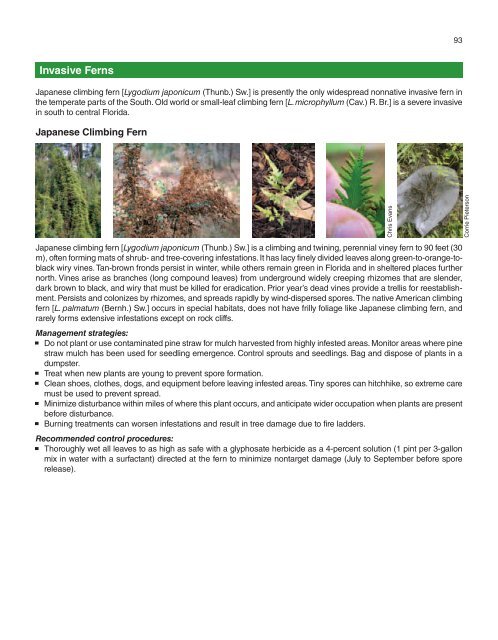A Management Guide for Invasive Plants in Southern Forests James ...
A Management Guide for Invasive Plants in Southern Forests James ...
A Management Guide for Invasive Plants in Southern Forests James ...
- No tags were found...
You also want an ePaper? Increase the reach of your titles
YUMPU automatically turns print PDFs into web optimized ePapers that Google loves.
93<strong>Invasive</strong> FernsJapanese climb<strong>in</strong>g fern [Lygodium japonicum (Thunb.) Sw.] is presently the only widespread nonnative <strong>in</strong>vasive fern <strong>in</strong>the temperate parts of the South. Old world or small-leaf climb<strong>in</strong>g fern [L. microphyllum (Cav.) R. Br.] is a severe <strong>in</strong>vasive<strong>in</strong> south to central Florida.Japanese Climb<strong>in</strong>g FernChris EvansCorrie PietersonJapanese climb<strong>in</strong>g fern [Lygodium japonicum (Thunb.) Sw.] is a climb<strong>in</strong>g and tw<strong>in</strong><strong>in</strong>g, perennial v<strong>in</strong>ey fern to 90 feet (30m), often <strong>for</strong>m<strong>in</strong>g mats of shrub- and tree-cover<strong>in</strong>g <strong>in</strong>festations. It has lacy f<strong>in</strong>ely divided leaves along green-to-orange-toblackwiry v<strong>in</strong>es. Tan-brown fronds persist <strong>in</strong> w<strong>in</strong>ter, while others rema<strong>in</strong> green <strong>in</strong> Florida and <strong>in</strong> sheltered places furthernorth. V<strong>in</strong>es arise as branches (long compound leaves) from underground widely creep<strong>in</strong>g rhizomes that are slender,dark brown to black, and wiry that must be killed <strong>for</strong> eradication. Prior year’s dead v<strong>in</strong>es provide a trellis <strong>for</strong> reestablishment.Persists and colonizes by rhizomes, and spreads rapidly by w<strong>in</strong>d-dispersed spores. The native American climb<strong>in</strong>gfern [L. palmatum (Bernh.) Sw.] occurs <strong>in</strong> special habitats, does not have frilly foliage like Japanese climb<strong>in</strong>g fern, andrarely <strong>for</strong>ms extensive <strong>in</strong>festations except on rock cliffs.<strong>Management</strong> strategies:Do not plant or use contam<strong>in</strong>ated p<strong>in</strong>e straw <strong>for</strong> mulch harvested from highly <strong>in</strong>fested areas. Monitor areas where p<strong>in</strong>estraw mulch has been used <strong>for</strong> seedl<strong>in</strong>g emergence. Control sprouts and seedl<strong>in</strong>gs. Bag and dispose of plants <strong>in</strong> adumpster.Treat when new plants are young to prevent spore <strong>for</strong>mation.Clean shoes, clothes, dogs, and equipment be<strong>for</strong>e leav<strong>in</strong>g <strong>in</strong>fested areas. T<strong>in</strong>y spores can hitchhike, so extreme caremust be used to prevent spread.M<strong>in</strong>imize disturbance with<strong>in</strong> miles of where this plant occurs, and anticipate wider occupation when plants are presentbe<strong>for</strong>e disturbance.Burn<strong>in</strong>g treatments can worsen <strong>in</strong>festations and result <strong>in</strong> tree damage due to fire ladders.Recommended control procedures:Thoroughly wet all leaves to as high as safe with a glyphosate herbicide as a 4-percent solution (1 p<strong>in</strong>t per 3-gallonmix <strong>in</strong> water with a surfactant) directed at the fern to m<strong>in</strong>imize nontarget damage (July to September be<strong>for</strong>e sporerelease).
















